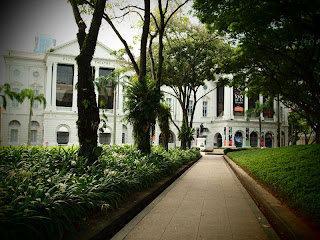Friday, April 12, 2013
ITE College West: Student's comics
Copyright (C) Mohammad Hirzi Bin Chahrul 2013
Copyright (C) Pei Ling 2013
Copyright (C) Huda 2013
Copyright (C) Ramdhan 2013
Copyright (C) Terence Koh Wei Jun 2013
Copyright (C) Ong Chin Hao 2013
Copyright (C) Lee Jun Hao 2013
Copyright (C) Zareen 2013
These comics were done by students at my Rediscover Cartoon and Comics Making workshop at ITE College West sometime in March 2013. It was a five sessions workshop, lasting two hours per session.The students were taught the basis of cartoon drawing (learning both the cartoon and manga style of drawing), character creation to storyboard planning and comics page layout.
Through years of teaching cartooning and fine art (children/youth art), I realised that drawing cartoon can be more challenging for some students compare to drawing or painting an artwork, moreover doing a comics strip/story. Comics are a result of drawing (characters, props, background etc.) and writing (story crafting). You need both to communicate an idea, a joke or a story. Despite the fact that one can get away with writing when you can produce good and clear drawing in comics, it won't be the other way around (just words) because the uniqueness of comics is the marriage of image and text. Comics will become a powerful medium when it draws out the emotion of readers and mesmerising them in a whirl pool of sensation.
Van Gogh's painting expressed through the eyes of young artists
The original painting done by Van Gogh.
This painting above was done by a student from Katong School and those below are by students from Max Tuition Centre. The differences between these two set of artworks is how they do it. The student who did the above painting were shown a coloured plate of the original Van Gogh painting while those students who did the painting below only got to see a monochrome copy of the painting. The children have to fill in the colour through imagination or what they knew about Van Gogh.
Painting class @ Katong School's art club
How a child view his/her surrounding is often expressed in a very different angle as compare to adults viewing the same scene. The richness of colours; the simplicity in shapes; the directness of one's emotion is often the key to responsive abstract painting.
Subscribe to:
Posts (Atom)


.jpg)




























